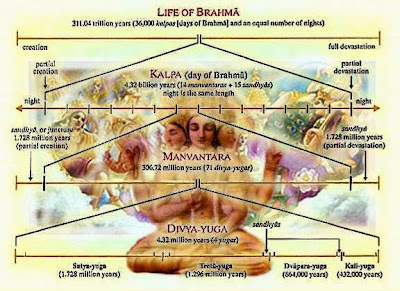THE ORIGIN OF VIDYA (KNOWLEDGE)
There are fourteen types of learning or Vidyas - four Vedas, Six Vedangs, Meemansa, Nyay, Puranas and other religious scriptures. These fourteen learning along with Ayurveda, Dhanurveda, Gandharvaveda and Arthashastra becomes eighteen. All these eighteen learning's originate from lord Shiva.
Lord Shiva created lord Brahma to felicitate the process of creation and bestowed him with all these eighteen learning's. He also empowered lord Vishnu to protect the creation.
The four Vedas emerged from the mouth of Lord Brahma, on the basis of which were created the numerous scriptures like Vedangs etc. Since these Vedas were difficult to understand, therefore lord Vishnu took incarnation of Vyasa and created the Puranas, so that they could be understood easily. The Puranas contain four lakh shlokas and they help us to understand the essence of the Vedas.
THE TALE OF NAIMISHARANYA
Once, lord Brahma released his Manomaya chakra and instructed the sages to follow it. He also told them that the place at which the Manomaya chakra broke down would be very auspicious for doing penance.
The sages followed the Manomaya chakra, which after travelling for a long time fell down on a large segment of land and its circumference (Nemi) broke down as predicted by lord Brahma. This segment of land became famous as Naimisharanya.
The sages decided to perform a Yagya at that sacred place. This way the very place, sitting where lord Brahma did creations. All the sages commenced their Yagya, which continued for ten thousand years. On the completion of Yagya, the deity arrived there and blessed them as per the instruction of lord Brahma.
TIME, CALCULATION, AND YUGAS
Describing about the time (Kala), Vayudeva told the sages that 'Kala' or time is the radiance of lord Shiva. Kala or time is also known as 'Kalatma'. The time flows smoothly without being disturbed.
Time is under the control of lord Shiva. Since the time contains the element of Shiva (Shivattatva), hence its momentum can not be checked by any other power, except that of Shiva. One, who understands the meaning of Kala, has a darshan of lord Shiva.

The smallest unit for measuring the time is called 'Nimesh'. The time taken to drop one's eyelid is called one Nimesh. A kala consists of fifteen Nimeshas and thirty Kalas make a 'Muhurta'.
A day and a night consist of thirty 'Muhurtas'. A month consists of thirty days, divided into two fortnights. One fortnight is known as 'Krishna Paksha (dark lunar phase) and the other is known as Shukla Paksha (bright lunar phase).
In Pitarloka the day consists of one fortnight and night of the same number of days. Shukla Paksha is the day of the Pitraloka and Krishna Paksha the night.
One 'Ayana' consists of Six months. A year consists of two 'Ayanas'. One year of the earth is equivalent to a day and a night of the deities. The six months when Sun is in the southern hemisphere of the earth, is actually the time when the deities experience night. On the contrary, the six months when sun is in the northern hemisphere, is the day time of the deities. One year of the deities is equivalent to three hundred and sixty years of this world.
The yugas are counted on the basis of the years of the deities. According to the scholars there are four yugas - Satya Yuga, Treta Yuga, Dwapar Yuga and Kali Yuga.
A Satya Yuga is equivalent to four thousand years of the deities.
A Treta Yuga is equivalent to three thousand years of the deities.
Similarly a Dwapar Yuga is equivalent to two thousand years of the deities and a Kali Yuga to that of one thousand years of the deities.
This way all the four yugas collectively are equivalent to twelve thousand years of the deities.
A Kalpa consists of one thousand Chaturyugas. A Manvantar consists of seventy one Chaturyugas.
One Kalpa is inhibited by fourteen Manus one after another in succession.
A Brahma's day is equivalent to one divine Kalpa. A Brahma's year is equivalent to one thousand Kalpas. A Brahma's yuga consists of eight thousand such years.
A Brahma's 'Savan' consists of his one thousand yugas. Brahma's life span is complete after three thousand such Sawanas. Five lakh and forty thousand numbers of Indras succeed one after another during the whole life span of Brahma.
A Vishnu day is equivalent to the whole life span of Brahma. The whole life span of Vishnu is equivalent to a day of 'Rudra'. The whole life span of Rudra is equivalent to a day of lord Shiva. In the whole life of lord Shiva five lakh and four thousand numbers of Rudras come and go.
A Shiva's day commences with the creation and before the end of the night the whole creation gets annihilated. Sadashiva is eternal.
MEDITATION
Describing about meditation Vayudeva told the sages that to concentrate one's restless mind during meditative state, a man needs some kind of form (Swarupa) or appearance. Idol worship is very helpful in this regard. If an idol of the deity is worshipped with full devotion, then a time comes when a man can have its sight even in an empty space. Idol worship also helps a devotee to reach towards the almighty God, who is formless. It is easy for a devotee who believes in 'Sakar' (with form) to change over to the Nirakar (formless) worship of God. But it is very difficult for a devotee who believes in the formless almighty to switch over to Sakar mode of worship. The knowledge of Shiva's essence is a must attain salvation in both the modes of devotion.
No comments:
Post a Comment